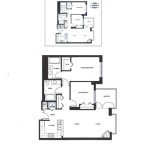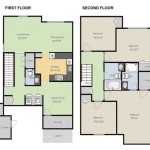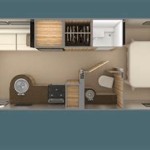A container home floor plan is a blueprint that outlines the layout and organization of a home built using shipping containers. It serves as a framework for designing the interior and exterior spaces, including the placement of rooms, windows, doors, and other structural elements. For instance, a typical container home floor plan might include multiple shipping containers configured side-by-side or stacked on top of each other, with each container designated for a specific purpose such as a bedroom, living room, or kitchen.
Creating a well-designed container home floor plan is crucial for optimizing space utilization, ensuring comfort and functionality, and facilitating a seamless flow of traffic throughout the home. It involves careful consideration of factors such as the number of containers used, the layout of interior spaces, the integration of natural lighting, and the placement of necessary utilities and appliances.
In the following sections, we will delve deeper into the key elements of container home floor plans, exploring various design options and providing practical tips for creating a floor plan that meets your specific needs and preferences. Whether you are planning to build a small, cozy container home or a spacious, multi-level structure, understanding the principles of container home floor planning will empower you to design a home that is both aesthetically pleasing and highly functional.
When designing a container home floor plan, there are several key considerations to keep in mind:
- Container Dimensions
- Space Optimization
- Natural Lighting
- Traffic Flow
- Utility Placement
- Insulation and Ventilation
- Exterior Access
- Code Compliance
- Personal Preferences
By carefully considering these factors, you can create a container home floor plan that meets your specific needs and preferences, ensuring a comfortable and functional living space.
Container Dimensions
Container dimensions play a crucial role in determining the overall layout and functionality of a container home floor plan. Shipping containers come in various standard sizes, with the most common being 20 feet and 40 feet in length. The width of a standard shipping container is typically 8 feet, while the height can vary depending on the type of container used. High-cube containers, for example, offer more interior height compared to standard containers.
When designing a container home floor plan, it is important to consider the dimensions of the containers you intend to use. The size of the containers will dictate the overall size and shape of your home, as well as the number of containers required to achieve your desired layout. For instance, a small container home might utilize a single 20-foot container, while a larger home may require multiple 40-foot containers arranged side-by-side or stacked on top of each other.
It is also important to consider the interior dimensions of the containers, as these will determine the usable space available for living, storage, and other purposes. The interior dimensions of a standard 20-foot container are approximately 19 feet 4 inches in length, 7 feet 8 inches in width, and 7 feet 9 inches in height. A 40-foot container offers approximately 39 feet 6 inches in length, 7 feet 8 inches in width, and 7 feet 9 inches in height.
Understanding the dimensions of the containers you are using is essential for ensuring that your floor plan is both practical and functional. Careful planning and consideration of container dimensions will allow you to maximize space utilization, create a comfortable and inviting living environment, and avoid costly mistakes during the construction process.
Space Optimization
Space optimization is a crucial aspect of container home floor plan design, as it directly impacts the livability and functionality of the home. Shipping containers, while providing a sturdy and durable structure, have limited interior space, making it essential to utilize every square foot efficiently.
One effective space optimization technique is to carefully consider the placement of walls and partitions within the containers. By strategically positioning walls and partitions, it is possible to create separate rooms and designated areas for different purposes, such as bedrooms, living areas, kitchens, and bathrooms, without compromising on space or creating a cramped feeling.
Another important aspect of space optimization is to maximize vertical space. By incorporating lofts, mezzanines, and built-in storage solutions, you can create additional living and storage space without increasing the overall footprint of the home. Lofts and mezzanines can be used as sleeping areas, home offices, or additional storage space, while built-in storage solutions, such as shelves, drawers, and cabinets, can be integrated into walls, under stairs, and other unused spaces.
Multi-functional furniture is also a great way to optimize space in a container home. By choosing furniture pieces that serve multiple purposes, such as a sofa bed or a coffee table with built-in storage, you can save valuable floor space and create a more versatile and adaptable living environment.
By implementing these space optimization techniques, you can create a container home floor plan that maximizes space utilization, ensuring a comfortable and functional living space that meets your specific needs and preferences.
Natural Lighting
Natural lighting plays a vital role in creating a comfortable, healthy, and energy-efficient container home. By incorporating natural light into your floor plan, you can reduce reliance on artificial lighting, save energy, and improve the overall ambiance of your home.
- Maximize Window Placement:
Strategically place windows throughout your container home floor plan to allow for ample natural light. Consider the orientation of your home and the path of the sun to determine the best placement for windows. Large windows and skylights can flood your home with natural light, creating a bright and inviting atmosphere.
- Utilize Reflective Surfaces:
Incorporate reflective surfaces, such as light-colored walls, mirrors, and glossy finishes, into your floor plan to bounce natural light around the home. This can help distribute light more evenly and brighten up even the darkest corners of your container home.
- Consider Clerestory Windows:
Clerestory windows are high-placed windows that extend above eye level. They allow natural light to enter the home without compromising privacy or security. Clerestory windows are a great option for container homes with limited wall space or for bringing light into interior rooms.
- Design an Open Floor Plan:
An open floor plan can help maximize the flow of natural light throughout your container home. By minimizing the use of walls and partitions, you can create a more spacious and living environment. Open floor plans are particularly well-suited for container homes with multiple containers, as they allow light to penetrate deep into the home.
By incorporating these natural lighting techniques into your container home floor plan, you can create a bright, inviting, and energy-efficient home that is filled with natural light and fresh air.
Traffic Flow
Traffic flow is an important consideration in container home floor plan design, as it affects the functionality, comfort, and safety of the home. A well-designed traffic flow ensures that occupants can move around the home easily and safely, without feeling cramped or restricted.
- Create a Clear Entryway:
The entryway of your container home should be clear and inviting, allowing occupants to enter and exit the home without obstruction. Avoid placing furniture or other obstacles in the entryway that could impede traffic flow.
- Define Main Pathways:
Identify the main pathways that occupants will use to move around the home, such as the path from the entryway to the living room or kitchen. Ensure that these pathways are wide enough to accommodate comfortable movement and that they are free of obstacles.
- Separate Public and Private Areas:
Consider separating public areas, such as the living room and kitchen, from private areas, such as bedrooms and bathrooms. This separation helps to create a more private and intimate atmosphere in the bedrooms and bathrooms, while also reducing noise and disturbances in the public areas.
- Minimize Hallways:
Hallways can take up valuable space in a container home. By minimizing the use of hallways and incorporating open floor plans, you can create a more spacious and efficient living environment. However, if hallways are necessary, ensure that they are wide enough to allow for comfortable movement.
By carefully considering traffic flow in your container home floor plan, you can create a home that is both functional and comfortable, providing a smooth and effortless flow of movement for occupants.
Utility Placement
Utility placement is a crucial aspect of container home floor plan design, as it directly impacts the functionality, comfort, and safety of the home. Utilities, such as plumbing, electrical, and HVAC systems, need to be carefully planned and integrated into the floor plan to ensure efficient operation and accessibility for maintenance and repairs.
- Plumbing Placement:
Plumbing fixtures, such as sinks, toilets, and showers, should be strategically placed to minimize the length of plumbing runs and avoid potential leaks or blockages. Consider grouping plumbing fixtures together, such as placing the bathroom and kitchen adjacent to each other, to simplify plumbing installation and maintenance.
- Electrical Placement:
Electrical outlets, switches, and lighting fixtures should be carefully placed to ensure convenient access and adequate lighting throughout the home. Consider the placement of furniture and appliances when planning electrical outlets to avoid overloading circuits or creating tripping hazards. Additionally, electrical panels and circuit breakers should be easily accessible for maintenance and troubleshooting.
- HVAC Placement:
The placement of heating, ventilation, and air conditioning (HVAC) systems is critical for maintaining a comfortable indoor environment. Consider the size and layout of the home, as well as the local climate, when selecting and placing HVAC units. Ensure that HVAC ducts and vents are properly sized and installed to provide efficient air distribution and temperature control.
- Appliance Placement:
Major appliances, such as refrigerators, stoves, and dishwashers, should be placed in designated areas, such as the kitchen, to ensure proper ventilation and accessibility. Consider the size and configuration of appliances when planning their placement to avoid overcrowding or creating obstacles in the living space.
By carefully considering utility placement in your container home floor plan, you can create a home that is both functional and comfortable, ensuring the efficient operation of utilities and minimizing the risk of disruptions or maintenance issues.
Insulation and Ventilation
Insulation and ventilation are crucial aspects of container home floor plan design, as they directly impact the comfort, energy efficiency, and overall health of the occupants. Proper insulation helps to regulate indoor temperatures, reduce energy consumption, and minimize noise levels, while adequate ventilation ensures a healthy indoor air quality and prevents moisture buildup.
- Insulation Materials:
Choosing the right insulation materials is essential for effective insulation. Common insulation materials used in container homes include spray foam, fiberglass batts, and cellulose insulation. Spray foam provides excellent insulation value and air sealing, but it can be more expensive than other options. Fiberglass batts are a cost-effective and widely available insulation material, but they require proper installation to avoid gaps and air leaks. Cellulose insulation is made from recycled paper and offers good insulation value, but it is susceptible to moisture absorption.
- Insulation Placement:
Insulation should be installed in all exterior walls, floors, and ceilings of the container home. It is important to ensure that there are no gaps or voids in the insulation, as these can create thermal bridges and reduce the effectiveness of the insulation. Pay special attention to areas around windows, doors, and other openings, as these are common areas for heat loss.
- Ventilation Systems:
Proper ventilation is essential for maintaining a healthy indoor air quality and preventing moisture buildup. Container homes, due to their airtight construction, require a well-designed ventilation system to ensure adequate air exchange. Common ventilation systems used in container homes include natural ventilation, mechanical ventilation, and heat recovery ventilation (HRV) systems.
- Ventilation Placement:
Ventilation openings should be strategically placed throughout the container home to ensure even air distribution. Vents should be placed near windows and doors to allow for cross-ventilation. Exhaust fans can be installed in areas that generate moisture, such as bathrooms and kitchens, to remove excess moisture and odors.
By incorporating proper insulation and ventilation into your container home floor plan, you can create a comfortable, energy-efficient, and healthy living environment that promotes well-being and reduces the risk of health issues related to poor indoor air quality.
Exterior Access
Exterior access in a container home floor plan refers to the placement and design of doors, windows, and other openings that allow occupants to enter and exit the home, as well as access outdoor spaces such as patios, decks, and gardens.
When planning exterior access in a container home floor plan, several factors need to be considered:
- Number and placement of doors:
The number and placement of doors in a container home floor plan depend on the size and layout of the home, as well as the desired level of privacy and security. Common door types used in container homes include sliding doors, French doors, and traditional hinged doors. Consider the flow of traffic and the placement of furniture when determining the optimal placement of doors.
- Window placement and size:
Windows provide natural light, ventilation, and views of the outdoors. The placement and size of windows in a container home floor plan should be carefully considered to maximize natural light and minimize heat loss. Large windows can provide stunning views and a connection to the outdoors, but they can also increase energy consumption. Consider the orientation of the home and the local climate when selecting window sizes and placements.
- Outdoor spaces:
If desired, outdoor spaces such as patios, decks, and gardens can be incorporated into the container home floor plan. Patios and decks provide additional living space and allow occupants to enjoy the outdoors without leaving the home. Gardens can provide fresh produce and enhance the aesthetic appeal of the home. Consider the size and orientation of the outdoor space, as well as the desired level of privacy, when planning its integration into the floor plan.
- Security features:
Security features, such as locks, alarms, and security lighting, should be incorporated into the exterior access plan to ensure the safety and security of the home and its occupants. Consider the placement of security features to maximize their effectiveness and minimize inconvenience.
By carefully considering exterior access in a container home floor plan, you can create a home that is both functional and inviting, providing seamless access to the outdoors and ensuring the safety and security of the occupants.
Code Compliance
Code compliance is of utmost importance when designing a container home floor plan. Building codes are regulations established by local authorities to ensure the safety, structural integrity, and habitability of buildings. Adhering to building codes is essential to obtain building permits, pass inspections, and ensure the safety of occupants.
When designing a container home floor plan, it is crucial to consult with local building officials to determine the specific codes and regulations that apply to container homes in your area. Building codes may vary depending on the jurisdiction, so it is important to be aware of the specific requirements in your location. Common building codes that apply to container homes include:
- Structural codes: These codes ensure that the container home is structurally sound and can withstand the loads it is subjected to, such as wind, snow, and seismic forces.
- Fire codes: These codes regulate the use of fire-resistant materials, fire detection and suppression systems, and egress routes to ensure the safety of occupants in case of a fire.
- Electrical codes: These codes ensure that the electrical system is installed safely and meets the required standards for electrical safety.
- Plumbing codes: These codes regulate the installation of plumbing systems to ensure the proper functioning of water supply, drainage, and waste disposal.
Failure to comply with building codes can result in denied building permits, failed inspections, and potential legal liabilities. Therefore, it is essential to carefully consider code compliance when designing a container home floor plan and to work with qualified professionals, such as architects and engineers, to ensure that the design meets all applicable codes and regulations.
In addition to local building codes, there are also national and international codes that may be relevant to container home design. These codes provide guidance on best practices for container home construction and can be used to supplement local building codes. Some examples of national and international codes include the International Building Code (IBC), the International Residential Code (IRC), and the American Society of Civil Engineers (ASCE) standards. By adhering to both local and national/international codes, you can ensure that your container home floor plan meets the highest standards of safety and quality.
Personal Preferences
When designing a container home floor plan, it is essential to consider your personal preferences and lifestyle to create a home that truly meets your needs and aspirations. Personal preferences play a significant role in shaping the layout, design, and overall ambiance of your container home.
One important aspect to consider is the desired level of openness and privacy. Some individuals prefer open floor plans that foster a sense of spaciousness and encourage interaction, while others may prefer a more traditional layout with separate rooms for privacy and quiet. The floor plan should be designed to accommodate your desired level of privacy and create a comfortable living environment.
Another personal preference to consider is the integration of indoor and outdoor spaces. Container homes offer unique opportunities to connect with the outdoors, and many homeowners choose to incorporate outdoor living areas into their floor plans. Patios, decks, and gardens can extend the living space and provide a seamless transition between the interior and exterior of the home.
The choice of materials and finishes is also a matter of personal preference. Container homes can be customized with a wide range of materials, from wood and metal to glass and concrete. The selection of materials and finishes should reflect your personal style and create a home that is both aesthetically pleasing and functional.
By carefully considering your personal preferences and lifestyle, you can create a container home floor plan that is tailored to your specific needs and desires. Your home should be a reflection of your personality and provide a comfortable and enjoyable living environment for you and your family.










Related Posts








